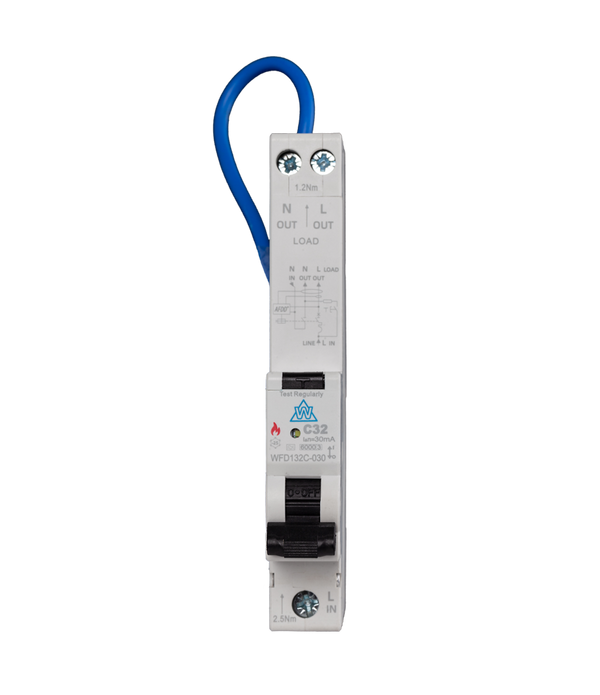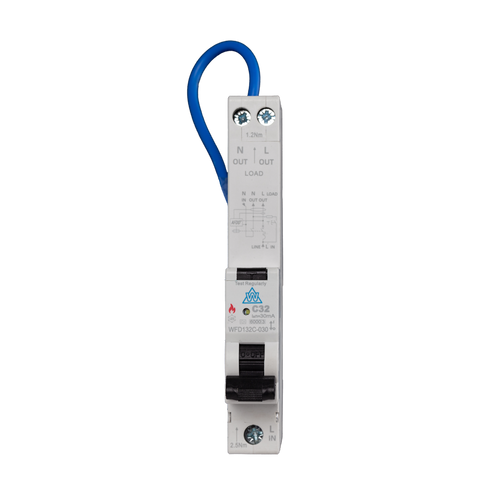Arc Fault Detection A-Type RCBO – WFD106B-030 (6A, B Curve, 30mA)
18th Ed. Compliant
2-Year Warranty
UK Stock
Free Delivery £30+
Secure Payments With


The WFD106B-030 is a 6A, B Curve Arc Fault Detection (AFDD) RCBO, combining arc fault detection, residual current protection (30mA), short-circuit, and overload protection into a single compact module. Built to BS 7671:2018 (18th Edition) standards, it delivers the highest level of fire prevention for modern installations. Unlike a standard...
The WFD106B-030 is a 6A, B Curve Arc Fault Detection (AFDD) RCBO, combining arc fault detection, residual current protection (30mA), short-circuit, and overload protection into a single compact module. Built to BS 7671:2018 (18th Edition) standards, it delivers the highest level of fire prevention for modern installations.
Unlike a standard RCBO, this device features a microprocessor-controlled Arc Fault Detection Device (AFDD). It continuously monitors the electrical waveform, identifying dangerous arcs caused by worn wiring, poor terminations, ageing circuits, or faulty appliances. When detected, it trips instantly, disconnecting live and neutral conductors to eliminate fire risk.
Installer Tip: The 6A model is best suited to lighting circuits in HMOs, rental properties, hotels, and other sleeping accommodation where fire prevention is critical.
Protective Coverage
The WFD1 series combines AFDD, MCB, and Type A RCD functionality, protecting against:
- Arc faults – series and parallel
- Overload and short-circuit events
- Residual current leakage – Type A (AC + pulsating DC)
- Overvoltage conditions – trips at 275V ±5%
Variant Comparison
| Model | Rating | Curve | Sensitivity |
|---|---|---|---|
| WFD106B-030 (This Product) | 6A | B Curve | 30mA |
| WFD110B-030 | 10A | B Curve | 30mA |
| WFD116B-030 | 16A | B Curve | 30mA |
| WFD120B-030 | 20A | B Curve | 30mA |
| WFD132B-030 | 32A | B Curve | 30mA |
| WFD140B-030 | 40A | B Curve | 30mA |
What does this 6A AFDD RCBO protect against?
It combines overload, short circuit, earth leakage, and arc fault protection in one device, making it ideal for high-risk lighting circuits in HMOs and sleeping accommodation.
Where should I install AFDD RCBOs?
BS 7671 recommends them on circuits supplying sleeping areas, HMOs, and commercial or rental premises where fire risk is higher.
Does it fully isolate the circuit?
Yes – the device disconnects both live and neutral conductors via its switched neutral design.
How wide is this device?
Just 17.8mm (single module), saving space in consumer units compared to traditional setups.
What other ratings are available?
The WFD1 Series includes 6A, 10A, 16A, 20A, 32A, and 40A models. This page is for the 6A WFD106B-030. For other ratings, see the comparison table above.
- SKU: WFD106B-030
- Type: AFDD + Type A RCBO
- Rating: 6A
- Curve: B
- Residual Current Sensitivity: 30mA
- Breaking Capacity: 6kA
- Operating Voltage: 230V AC, 50Hz
- Arc Fault Detection: Series & Parallel faults
- Additional Protection: Overload, short circuit, residual leakage, overvoltage (275V ±5%)
- Isolation: Disconnects live & neutral (switched neutral)
- Mounting: 1 module DIN rail
- Dimensions: 17.8 × 116 × 76 mm
- Compliance: BS EN 61009-1, BS EN 62606, BS 7671:2018 (18th Edition)
To be fitted by a qualified electrician in accordance with BS 7671. AFDD RCBOs are strongly recommended for circuits supplying sleeping accommodation, HMOs, and fire-risk locations.
- Use the 6A model for lighting circuits with fire-safety requirements
- Install on single-phase 230V AC circuits
- DIN rail mounted, single module (17.8mm)
- Not designed for DC systems
- Compatible with WCED consumer units and distribution boards



